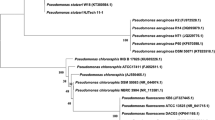Abstract
The culture supernatant of Pseudomonas cepacia (ATCC 39027) grown on 2,4,5-trichlorophenoxyacetic acid (2,4,5-T) was found to contain an agent which can emulsify 2,4,5-T. The emulsion is stable for several hours. The emulsifying agent was produced in response to growth on 2,4,5-T, although some emulsification was observed in culture supernatant of glucose grown cells. The emulsifying agent is most active with 2,4,5-T but has some activity towards other chlorinated compounds such as chlorophenols. In growing culture the emulsifying agent adheres to the cell surface as a slimy layer. The emulsifying agent is believed to have a role in transport of 2,4,5-T into the cells.
Similar content being viewed by others
Abbreviations
- BSM:
-
Basal salts medium
References
Audus LG (1960) Microbiological breakdown of herbicides in soil. In: Woodward EK, Sagar GR (ed) Herbicides and the soil. Blackwell Publishing, Oxford, pp 1–19
Beebe JL, Umbreit WW (1971) Extracellular lipids of Thiobacillus thiooxidans. J Bacteriol 108:612–614
Cooper DG, Zazic JR, Gerson DF (1979) Production of surface active lipids by Corynebacterium lopus. Appl Environ Microbiol 37:4–10
Cooper DG, Zazic JE (1980) Surface active compounds from microorganisms. Advances Appl Microbiol 26:229–253
Hisatsuka K, Nakahara T, Sano N, Yamada K (1971) Formation of rhamnolipid by Pseudomonas aeruginosa and its function in hydrocarbon fermentation. Agric Biol Chem 35:686–692
Iguchi J, Takeda I, Okasawa H (1969) Emulsifying factor of hydrocarbon assimilating yeast. Agric Biol Chem 33:1657–1658
Kellogg ST, Chatterjee DK, Chakrabarty AM (1981) Plasmid assisted molecular breeding — new technique for enhanced biodegradation of persistent toxic chemicals. Science 214:1133–1135
Kilbane JJ, Chatterjee DK, Karns JS, Kellogg ST, Chakrabarty AM (1982) Biodegradation of 2,4,5-trichlorophenoxy acetic acid by a pure culture Pseudomonas cepacia. Appl Environ Microbiol 44: 72–78
Lowry OH, Rosebrough NJ, Farr AL, Randall RJ (1951) Protein measurement with Folin phenol reagent. J Biol Chem 193:265–275
Phibbs PV Jr, Feary TN, Blevins WR (1974) Pyruvate carboxylase deficiency in pleotropic carbohydrate-negative mutant strains of Pseudomonas aeruginosa. J Bacteriol 118:999–1009
Rosenberg A, Alexander M (1980) 2,4,5-Trichlorophenoxy acetic acid (2,4,5-T) decomposition in tropical soil and its co-metabolism by bacteria in vitro. J Agric Food Chem 28:705–709
Rosenberg A, Zuckerberg A, Rubinowitz C, Gutnick DL (1979) Emulsifyer of Arthrobacter RAG-1: isolation and emulsifying properties. Appl Environ Microbiol 37:402–408
Shively JM, Benson AA (1967) Phospholipids of Thiobacillus thiooxidans. J Bacteriol 94:1679–1683
Author information
Authors and Affiliations
Rights and permissions
About this article
Cite this article
Banerjee, S., Duttagupta, S. & Chakrabarty, A.M. Production of emulsifying agent during growth of Pseudomonas cepacia with 2,4,5-trichlorophenoxyacetic acid. Arch. Microbiol. 135, 110–114 (1983). https://doi.org/10.1007/BF00408018
Received:
Accepted:
Issue Date:
DOI: https://doi.org/10.1007/BF00408018




